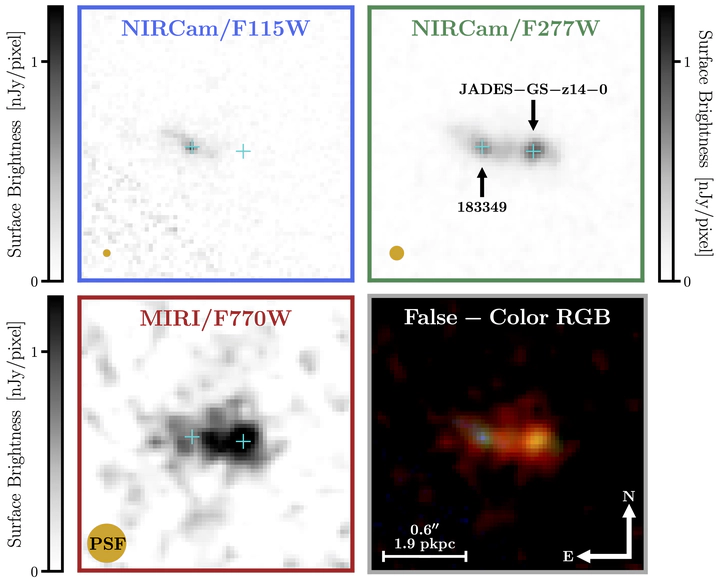Photometric detection at 7.7 microns of a galaxy beyond redshift 14 with JWST/MIRI
Photometric detection at 7.7 microns of a galaxy beyond redshift 14 with JWST/MIRI
May 28, 2024· ,,,,,,,,,,,,,,,,,,,,,,,,,,,,,,,,,
,,,,,,,,,,,,,,,,,,,,,,,,,,,,,,,,,
Dr. Jakob M. Helton
George H. Rieke
Stacey Alberts
Zihao Wu
Daniel J. Eisenstein
Kevin N. Hainline
Stefano Carniani
Zhiyuan Ji
William M. Baker
Rachana Bhatawdekar
Andrew J. Bunker
Phillip A. Cargile
Stéphane Charlot
Jacopo Chevallard
Francesco D'Eugenio
Eiichi Egami
Benjamin D. Johnson
Gareth C. Jones
Jianwei Lyu
Roberto Maiolino
Pablo G. Pérez-González
Marcia J. Rieke
Brant Robertson
Aayush Saxena
Jan Scholtz
Irene Shivaei
Fengwu Sun
Sandro Tacchella
Lily Whitler
Christina C. Williams
Christopher N. A. Willmer
Chris Willott
Joris Witstok
Yongda Zhu
 Figure 1 from Helton et al. (2024, Nature Astronomy, accepted).
Figure 1 from Helton et al. (2024, Nature Astronomy, accepted).Abstract
The James Webb Space Telescope (JWST) has spectroscopically confirmed numerous galaxies at $z > 10$
. While weak rest-ultraviolet emission lines have only been seen in a handful of sources, the stronger rest-optical emission lines are highly diagnostic and accessible at mid-infrared wavelengths with the Mid-Infrared Instrument (MIRI) of JWST. We report the photometric detection of the distant spectroscopically confirmed galaxy JADES-GS-z14-0 at $z = 14.32_{-0.20}^{+0.08}$
with MIRI at $7.7\ \mu\mathrm{m}$
. The most plausible solution for the stellar population properties is that this galaxy contains half a billion solar masses in stars with a strong burst of star formation in the most recent few million years. For this model, at least one-third of the flux at $7.7\ \mu\mathrm{m}$
comes from the rest-optical emission lines $\mathrm{H}\beta$
and/or $\mathrm{[OIII]}\lambda\lambda4959,5007$
. The inferred properties of JADES-GS-z14-0 suggest rapid mass assembly and metal enrichment during the earliest phases of galaxy formation. This work demonstrates the unique power of mid-infrared observations in understanding galaxies at the redshift frontier.
Type
Publication
eprint arXiv:2405.18462
Authors
Astrophysicist | Evolving Universe Postdoctoral Scholar | Science Communicator
Related
- JADES: Insights into the low-mass end of the mass-metallicity-SFR relation at 3 < z < 10 from deep JWST/NIRSpec spectroscopy
- JADES Data Release 3 -- NIRSpec/MSA spectroscopy for 4,000 galaxies in the GOODS fields
- JADES: The production and escape of ionizing photons from faint Lyman-alpha emitters in the epoch of reionization
- Resolving the nature and putative nebular emission of GS9422: an obscured AGN without exotic stars
- The Cosmos in Its Infancy: JADES Galaxy Candidates at z > 8 in GOODS-S and GOODS-N